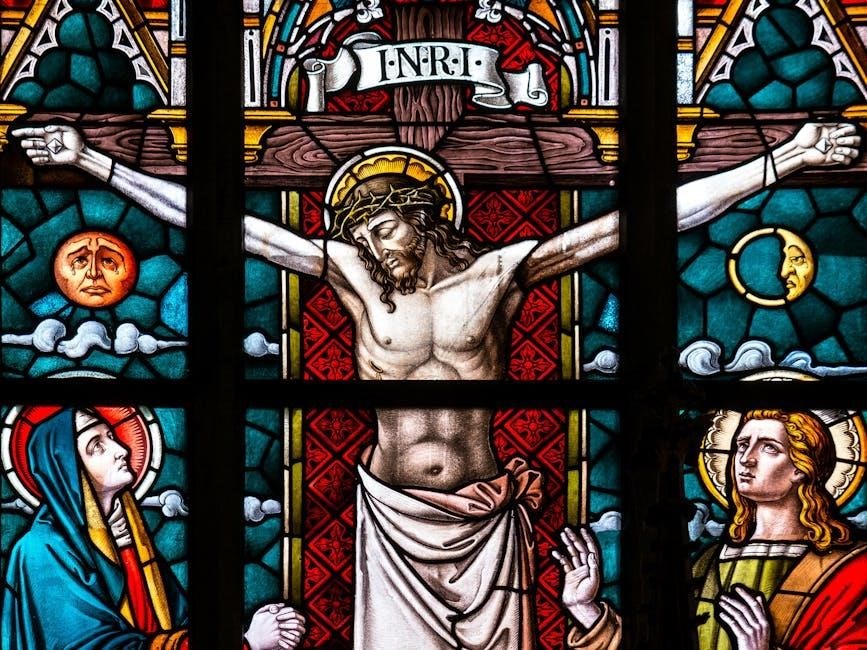The Armor of God, rooted in Ephesians 6:10-18, symbolizes spiritual protection for believers. These verses outline six pieces of armor, each representing a facet of faith and righteousness. Worksheets and printable resources help teach children about spiritual warfare, making biblical lessons engaging and accessible. This concept is vital for fostering faith in young minds.
1.1 Overview of the Armor of God
The Armor of God, as described in Ephesians 6:10-18, is a metaphorical set of spiritual defenses that believers are encouraged to “put on” to withstand spiritual battles. This concept is central to Christian teachings, emphasizing the importance of being prepared to face life’s challenges with faith and righteousness. The armor consists of six pieces: the belt of truth, the breastplate of righteousness, the gospel of peace, the shield of faith, the helmet of salvation, and the sword of the Spirit. Each piece serves a unique purpose, collectively providing protection and empowerment for living a godly life.
These worksheets and printable resources are designed to help individuals, especially children, understand and apply the Armor of God in their daily lives. By breaking down each component, the materials make complex spiritual concepts accessible and engaging. Activities such as coloring pages, memory cubes, and interactive lessons are included to reinforce biblical lessons. The goal is to equip learners with a deeper understanding of spiritual warfare and the tools needed to overcome it.
The Armor of God is not just a biblical metaphor but a practical guide for living a life rooted in faith and trust in God. Through these educational resources, individuals can gain a clearer grasp of how to “put on” the armor and walk in spiritual confidence. This overview provides a foundational understanding, preparing learners to delve deeper into each piece of armor and its significance.
1.2 Significance in Christian Teachings
The Armor of God holds profound significance in Christian teachings, serving as a metaphor for spiritual protection and empowerment. Rooted in Ephesians 6:10-18, this concept emphasizes the believer’s need to be prepared for spiritual warfare. The armor represents the attributes of God’s character and the tools necessary to stand firm against evil.
In Christian education, the Armor of God is often taught to children through engaging resources like worksheets, coloring pages, and memory cubes. These tools help young learners grasp the biblical lessons and apply them in their daily lives. The armor is not just a symbolic representation but a practical guide for living a life rooted in faith, righteousness, and trust in God.
The significance of the Armor of God lies in its ability to equip believers with the spiritual strength needed to navigate life’s challenges. It underscores the importance of relying on God’s power rather than human effort. By teaching this concept, Christian educators aim to instill a deep understanding of spiritual warfare and the importance of living a life aligned with God’s will.
Worksheets and printable resources are invaluable in making these teachings accessible and engaging, especially for children. They provide a hands-on approach to learning about the armor, helping young minds connect with the biblical text in a meaningful way. This educational focus ensures that the Armor of God remains a cornerstone of Christian teachings, equipping believers of all ages to face life’s spiritual battles with confidence and faith.
1.3 Target Audience for Worksheets
The Armor of God worksheets are primarily designed for children, serving as an engaging tool to teach them about spiritual warfare and biblical principles. These resources are particularly useful for Sunday school classes, homeschooling, and family devotionals. The target audience includes children aged 4-12, as the worksheets are created to be age-appropriate and easy to understand.
Parents and educators often use these worksheets to help kids grasp the concept of the Armor of God, as outlined in Ephesians 6:10-18. The interactive nature of these materials, such as coloring pages, word searches, and memory cubes, makes learning fun and effective. Additionally, the worksheets are beneficial for children who are beginning to explore their faith, providing a foundation for understanding spiritual protection and God’s plan for their lives.
The worksheets are also adaptable for use in small group settings, such as youth groups or Vacation Bible School. They serve as a practical way to reinforce biblical lessons and encourage children to apply the teachings of the Armor of God in their daily lives. By engaging with these resources, children develop a deeper understanding of their faith and are equipped to face life’s challenges with confidence and reliance on God.
Overall, the target audience for Armor of God worksheets includes children, parents, and educators seeking to impart spiritual truths in an accessible and engaging manner. These resources are a valuable tool for fostering faith and spiritual growth in young minds.

Key Concepts in Ephesians 6

Ephesians 6:10-18 introduces the Armor of God, emphasizing spiritual warfare and the need for believers to be equipped with divine protection. The passage highlights the importance of standing firm in faith, truth, and righteousness. These concepts form the foundation for understanding the purpose and significance of the Armor of God.
2.1 Biblical Context of Ephesians 6:10-18
Ephesians 6:10-18 is part of a larger letter written by the Apostle Paul to the church in Ephesus, encouraging believers to live a life worthy of their calling in Christ. This passage transitions from doctrinal teachings to practical Christian living, emphasizing the importance of spiritual preparedness. The context shifts to a call for believers to “be strong in the Lord and in His mighty power,” recognizing that their struggles are not against flesh and blood but against spiritual forces of evil.
Paul uses the metaphor of armor to illustrate the spiritual protection believers need to withstand these forces. Each piece of armor—such as the belt of truth, breastplate of righteousness, and shield of faith—represents a vital aspect of spiritual warfare. The passage serves as both a warning and an empowerment, urging believers to stand firm in their faith and trust in God’s provision.
This section is often taught to children through worksheets and printable resources, helping them understand the biblical basis of spiritual protection. The Armor of God becomes a relatable and memorable concept, equipping young minds with the knowledge of God’s truth and righteousness. By studying Ephesians 6:10-18, believers of all ages gain a deeper understanding of their spiritual identity and the tools available to them in their walk with Christ.
2.2 Understanding Spiritual Warfare
Spiritual warfare is a central theme in Ephesians 6:10-18, where the Apostle Paul describes the Christian life as a battle against unseen spiritual forces. These forces are identified as “the rulers, the authorities, the powers of this dark world, and the spiritual forces of evil in the heavenly realms.” This warfare is not physical but spiritual, requiring believers to rely on divine strength and protection.
The concept of spiritual warfare emphasizes that believers are engaged in a cosmic conflict, where Satan and his forces seek to deceive, tempt, and destroy. Paul urges believers to “put on the full armor of God” to stand firm against these attacks. Each piece of armor represents a spiritual truth or practice that equips believers to resist evil and live victoriously.
Understanding spiritual warfare helps believers recognize that their struggles are not merely personal or circumstantial but have a deeper spiritual dimension. It encourages them to trust in God’s power and provision rather than their own strength. This teaching is often simplified in worksheets and printable resources for children, using visual and interactive methods to explain the Armor of God. By grasping these concepts, believers, especially children, can develop a strong spiritual foundation and learn to trust in God’s protection and guidance in their daily lives.

Components of the Armor of God
The Armor of God, as outlined in Ephesians 6:10-18, consists of six spiritual pieces: the Belt of Truth, Breastplate of Righteousness, Gospel of Peace, Shield of Faith, Helmet of Salvation, and the Sword of the Spirit. These components symbolize protection and empowerment for believers in spiritual battles. Worksheets and printables often detail each piece, helping children and learners understand their significance and application in daily life.
3.1 Belt of Truth
The Belt of Truth, as mentioned in Ephesians 6:14, is the first piece of the Armor of God. It symbolizes the importance of truth and integrity in a believer’s life. This belt holds the armor together, representing how truth binds and strengthens our spiritual foundation. Worksheets and printables often focus on this piece, helping children and learners understand its significance. Activities such as crossword puzzles, coloring pages, and memory verses emphasize the role of truth in spiritual warfare. The belt reminds us to stand firm in God’s Word, rejecting lies and deception. By teaching this concept, worksheets enable individuals to apply biblical truths in their daily lives, fostering a strong moral compass. This piece of armor is essential for believers to remain grounded and protected in their faith journey.
3.2 Breastplate of Righteousness
The Breastplate of Righteousness, mentioned in Ephesians 6:14, is a vital piece of the Armor of God. It represents the believer’s righteousness, which comes from a personal relationship with Christ. This breastplate protects the heart, symbolizing the importance of moral integrity and a clear conscience. Worksheets and printables often include activities that help learners understand how righteousness guards against spiritual attacks. For children, these resources might feature puzzles, coloring pages, or matching games that highlight key verses. The breastplate teaches the value of living a life aligned with God’s standards, emphasizing honesty and purity. By incorporating this concept into lessons, educators help individuals develop a strong moral foundation. This piece of armor reminds believers that their righteousness is not self-earned but is a gift from God, enabling them to stand confidently in spiritual battles. Worksheets and interactive tools make this abstract idea relatable and practical for all ages. The Breastplate of Righteousness is a powerful reminder of God’s grace and the importance of living a life that reflects His character.
3.3 Gospel of Peace
The Gospel of Peace, as mentioned in Ephesians 6:15, is a crucial component of the Armor of God. It represents the Good News of Jesus Christ and the peace that comes from knowing Him. This piece of armor serves as a foundation for believers, enabling them to stand firm in spiritual battles. Worksheets and printables often highlight this concept, helping learners understand its significance. The Gospel of Peace reminds us that true stability and hope come from God, even in chaotic times.
Educational resources, such as coloring pages and word searches, can help children grasp this idea. Activities might include matching games that connect Bible verses to the armor pieces, reinforcing the message of peace. For instance, a worksheet might ask kids to draw a scene depicting peace or write a short prayer thanking God for His peace.
This armor piece also teaches the importance of sharing the Gospel with others, as it brings peace to those who receive it. Worksheets might include puzzles or mazes with verses like Ephesians 6:15, making learning interactive and fun. The Gospel of Peace is not just a defensive tool but also a reminder of God’s love and grace. By incorporating this concept into lessons, educators help children develop a strong spiritual foundation. This piece of armor encourages believers to walk in peace and share it with the world.
3.4 Shield of Faith
The Shield of Faith, mentioned in Ephesians 6:16, is a vital piece of the Armor of God. It symbolizes the believer’s trust in God’s power and protection against spiritual attacks. This shield is not just a defensive tool but also a declaration of unwavering faith in God’s promises. Worksheets and printables often focus on this concept, helping learners understand its significance in spiritual warfare.
Educational resources, such as coloring pages and puzzles, can help children visualize the Shield of Faith. Activities might include matching games where kids connect Bible verses to the armor pieces, reinforcing the idea of faith as a protective barrier. For example, a worksheet might ask children to draw a shield with phrases like “I trust God” or “He is my protector.”
The Shield of Faith also teaches the importance of standing firm in belief, even when faced with challenges. Worksheets might include fill-in-the-blank exercises where children complete sentences like, “My faith in God helps me ______.” This interactive approach makes learning engaging and memorable.
By incorporating the Shield of Faith into lessons, educators help children develop a strong spiritual foundation. This piece of armor reminds believers that faith is not just a feeling but a choice to trust God, no matter the circumstances. Worksheets and activities ensure that this powerful truth is passed on to the next generation.

3.5 Helmet of Salvation
The Helmet of Salvation, mentioned in Ephesians 6:17, is a crucial piece of the Armor of God. It symbolizes the believer’s assurance of salvation and serves as spiritual protection for the mind and heart. This helmet guards against doubts, fears, and lies, ensuring clarity and confidence in God’s plan.
Worksheets and printables often highlight the Helmet of Salvation, helping learners grasp its significance. Activities might include coloring pages featuring helmets with Bible verses or word searches that focus on salvation-themed words. These tools make complex spiritual concepts accessible to children.
The Helmet of Salvation also teaches the importance of trusting in God’s redemption. Worksheets might include puzzles or matching games where kids connect biblical promises to the armor pieces. For example, a worksheet could ask children to write their favorite Bible verses about salvation on a helmet-shaped template.
Educational resources emphasize how the Helmet of Salvation equips believers to withstand spiritual battles. By incorporating this concept into lessons, educators help children understand the assurance of their faith. Worksheets and activities ensure that the Helmet of Salvation is not just a biblical symbol but a lived reality for young learners. This piece of armor reminds believers that their salvation is a gift and a source of strength in everyday life.
Understanding the Purpose of Worksheets
Worksheets on the Armor of God are designed to engage children in spiritual learning through interactive activities. They reinforce biblical lessons, helping kids understand and apply Ephesians 6:10-18. These tools foster a deeper connection with faith, making complex concepts accessible and fun. They are ideal for Sunday school or home use.
4.1 Educational Goals
The primary educational goal of Armor of God worksheets is to help children understand and apply the biblical teachings from Ephesians 6:10-18. These resources are designed to make complex spiritual concepts accessible and engaging for young learners. By incorporating activities such as puzzles, word searches, and coloring pages, worksheets aim to capture children’s attention while reinforcing key lessons about spiritual warfare and protection.

One of the main objectives is to foster a deeper understanding of the Armor of God, enabling kids to recognize its significance in their daily lives. Worksheets often include memory verses, discussion questions, and interactive exercises that encourage children to reflect on how each piece of armor—such as the Belt of Truth or the Shield of Faith—can be practically applied.

Additionally, these educational tools aim to develop critical thinking and problem-solving skills through activities that require children to connect biblical teachings with real-life scenarios. By doing so, worksheets help children build a strong spiritual foundation, equipping them to navigate challenges with faith and confidence. The ultimate goal is to create a fun and engaging learning experience that fosters spiritual growth and a lifelong connection to God’s Word.
4.2 Engaging Children in Spiritual Learning
Engaging children in spiritual learning is a cornerstone of Armor of God worksheets. These resources are designed to capture young minds through interactive and visually appealing activities, making biblical teachings both fun and memorable. By incorporating elements like coloring pages, puzzles, and word searches, worksheets help children connect with the concept of spiritual armor in a way that feels relevant and exciting.
One of the key strengths of these worksheets is their ability to present complex spiritual ideas in a simple, child-friendly format. For example, coloring pages depicting each piece of armor—such as the Helmet of Salvation or the Shield of Faith—allow children to visualize and internalize these symbols. Similarly, puzzles and matching games reinforce memory verses and key concepts, helping kids retain the lessons long after the activity is complete.
Interactive learning tools also encourage children to think creatively about their faith. Activities like drawing their own armor or writing prayers related to each piece of armor foster a sense of personal connection to the material. Group discussions and games further enhance engagement, turning spiritual learning into a collaborative and enjoyable experience. By making learning interactive and hands-on, Armor of God worksheets help children develop a strong foundation of faith while keeping them excited about exploring God’s Word.
4.3 Reinforcing Biblical Lessons
Armor of God worksheets are a powerful tool for reinforcing biblical lessons in a way that is both engaging and memorable for children. These resources are designed to help young learners grasp the teachings of Ephesians 6:10-18, which detail the spiritual armor believers are called to wear. By breaking down each piece of armor—such as the Belt of Truth, the Breastplate of Righteousness, and the Shield of Faith—worksheets provide a clear and structured approach to understanding these biblical concepts.
One of the key benefits of these worksheets is their ability to reinforce memory verses and key teachings. Activities such as fill-in-the-blank exercises, word searches, and matching games help children commit important scriptures to memory. For example, a worksheet might focus on Ephesians 6:14-17, guiding children to identify and write down the specific pieces of armor mentioned in the passage. This repetition and interaction with the text make the lessons more likely to stick in their minds.
Additionally, these worksheets often include reflection questions or drawing activities that encourage children to think about how the armor applies to their own lives. For instance, a worksheet might ask, “How can you use the Shield of Faith in your daily life?” This helps children connect the biblical teachings to real-world situations, making the lessons more practical and relevant.
Overall, Armor of God worksheets are an effective way to reinforce biblical lessons, ensuring that children not only understand the teachings of Ephesians 6 but also apply them in their lives.
4.4 Developing Interactive Learning Tools

Interactive learning tools, such as Armor of God worksheets, are essential for making spiritual education engaging and effective for children. These resources are designed to go beyond passive learning by incorporating activities that require participation and creativity. For example, puzzles, coloring pages, and matching games are often included to help kids interact with the material in a fun and dynamic way.
One of the key features of these worksheets is their ability to break down complex biblical concepts into simple, understandable parts. For instance, a worksheet might include a word search where children find terms like “Belt of Truth” or “Shield of Faith,” reinforcing their memory of these pieces of armor. Similarly, crossword puzzles or fill-in-the-blank exercises can help children learn and retain key verses from Ephesians 6.

Another important aspect of these tools is their visual appeal. Many worksheets include illustrations of the armor, allowing children to visualize each piece and its significance. Coloring pages, for example, provide an artistic outlet while reinforcing the lessons. These activities not only make learning enjoyable but also help children develop a deeper connection to the material.

By combining education with entertainment, Armor of God worksheets create a holistic learning experience. They empower children to engage with biblical teachings actively, fostering a strong spiritual foundation. These tools are particularly valuable for Sunday school classes, homeschooling, or family devotionals, offering a practical way to teach kids about spiritual warfare and protection.

